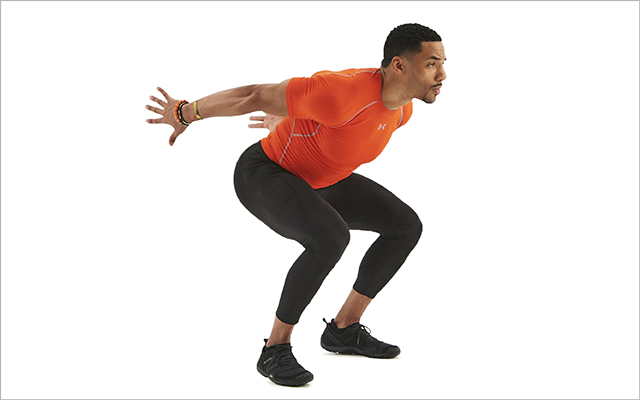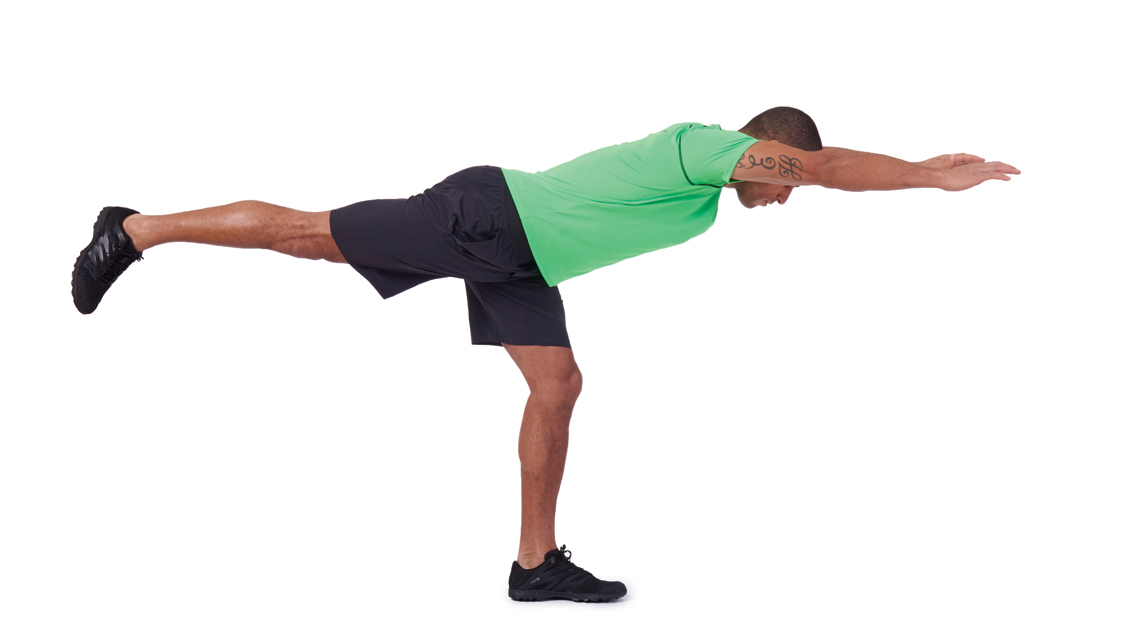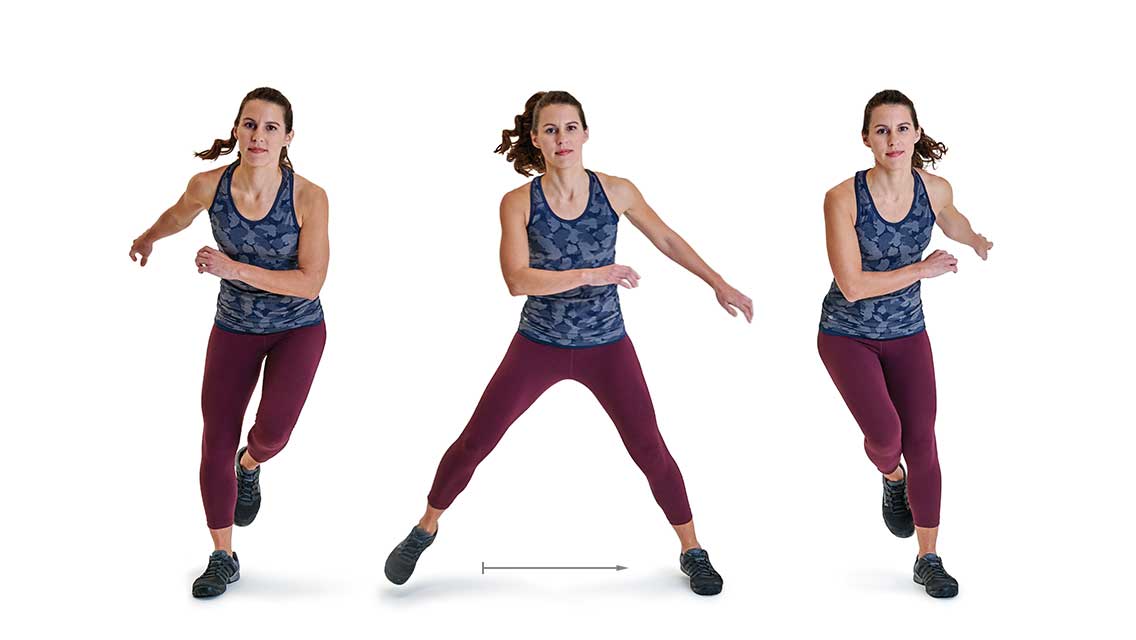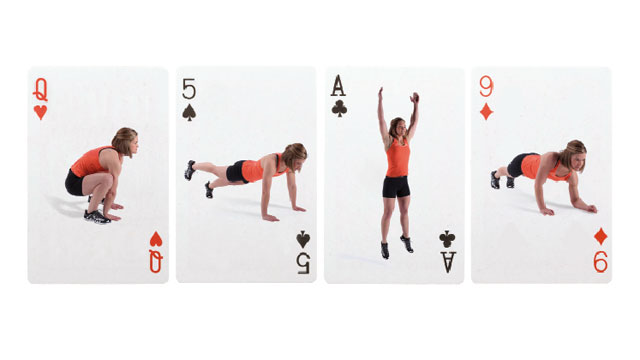Access to a well-equipped health club makes sticking to a workout regimen easier. But sometimes getting to the gym just isn’t in the cards. Maybe you’re on vacation or in a hotel on a business trip. Maybe you’re home with a sick kid. Maybe you’re working late on a deadline and haven’t left your cubicle since lunch.
Granted, these situations can make you feel harried or unmotivated. Still, none truly stands in the way of a good workout.
“It’s the mental piece of our day-to-day life that allows us to create and make change,” says David Freeman, NASM-PES, OPEX CCP, national manager of Alpha Training at Life Time in Chanhassen, Minn. “Mind right, body right.”
One strategy that can help you stick with an exercise regimen no matter what life throws your way is to go minimal.
Freeman designed this workout based on the following constraints: a 30-minute-or-less circuit you can do in a space about the size of a yoga mat — small enough for a studio apartment, hotel room, rest stop, even the corner of a crowded gym — with no equipment.
It’s a high-intensity routine that will hit all your major muscle groups, get your heart pounding, and clear your head. All you need is your own body weight to perform the moves and an open mind to overcome the inner voice that insists you can’t make it work.
Still not convinced that a brief, small-space workout is worth the effort during these times of stress? Then consider this: A 2013 study published in Frontiers in Psychiatry found that working out reduces anxiety and catastrophic thinking. The researchers discovered that physical activity stimulates brain-derived neurotrophic factor (BDNF), a depression-busting protein that can increase feelings of control and mastery. In other words, exercise is one of your most effective tools in stressful times.
Ready to get started? All you need to remember here is the lucky number 13.
The Workout
This minimalist workout, designed by Life Time’s David Freeman (pictured), consists of five exercises you perform as a circuit, using only your body weight for resistance.
The goal is to complete as many good-form reps of each move as you can in as short a time as possible — a beginner might finish in 40 minutes, an advanced trainee in 20. Modify the moves to make them easier or harder as needed, and adjust your pace and rep count to suit your -current fitness level.
Directions
On a piece of paper, write down the numbers 1 to 13 in any random order. These numbers will represent the number of repetitions for each exercise.
- Start a stopwatch.
- Warm up with 20 reps of exercise A (burpees).
- Starting with the first number on your list, perform that many reps of exercises B through E, in that order. So if the first number on your list is 11, do 11 sit-ups, 11 mountain climbers, 11 jump squats, and 11 hand-release pushups.
- Cross that number off your list, and proceed until you’ve crossed off every number. In all, you will perform a total of 91 reps each of moves B through E.
- Finish the workout with 20 more burpees.
- Stop the watch and record your time. That’s what you’ll try to beat next time.
Make it easier: Lop off a few numbers (use the numbers 1 to 11 or 5 to 13, for example, instead of 1 to 13), or add a time restriction of 25 minutes.
Make it harder: If you get through the entire workout in under 20 minutes, use the numbers 1 to 14 or 1 to 15 next time.
The Exercises
A. Burpee (Warm-Up and Finisher)
- Assume an athletic stance — feet shoulder width apart, core engaged, and gaze forward.
- Keeping your lower back in its natural arch, bend at the hips and knees, and place your hands on the floor. (For an extra challenge, jump your feet back with control as your hands reach the floor.)
- Jump your feet backward into a high plank position: feet about shoulder width apart or a little wider. (Make it harder by performing a pushup.)
- Jump your feet forward to a squat position. (Make it harder by lifting your hands off the floor as you jump to a squat.)
- Keeping your back flat, jump straight up from the squat and return to standing. Repeat. (For additional form tips, check out “How to Do a Burpee”.)
B. Sit-Up
- Lie on your back with your knees bent and heels planted.
- Position your hands near your ears, elbows pointing out.
- Without jerking or pulling on your head or neck, sit up.
- Reverse the move, lowering yourself back to the floor.
C. Mountain Climber
- Assume a pushup position — hands and feet slightly wider than shoulder width, arms locked out, and body straight from your heels to the top of your head.
- Brace your core to keep your midsection tight while pulling one knee toward your chest, keeping your raised foot flexed.
- Tap your toe on the floor, then quickly return it to the start position while pulling the opposite knee toward your chest. That’s one rep.
- Continue alternating feet for the assigned number of reps.
D. Jump Squat
- Assume an athletic stance.
- Squat down as far as you comfortably can with feet flat. Then, driving your arms forward and upward with one explosive movement, jump up as high as you can.
- Land softly on the balls of your feet and, upon landing, squat down and immediately jump again.
E. Hand-Release Pushups
- Assume a pushup position.
- Keeping your body straight and your head in a neutral position, simultaneously bend your arms and retract your shoulder blades until your chest touches the floor.
- Lift your hands off the floor for a moment while still engaging your core, and then press yourself up to the starting position.
This originally appeared as “No Space? No Equipment? No Problem!” in the October 2017 print issue of Experience Life.




This Post Has 0 Comments